Discover the 8 Longest Bridges in Alabama
Spanning across the beautiful landscapes of Alabama is a collection of remarkable bridges. These not only serve as critical transportation links but also contribute to the state’s rich history. In this article, we embark on a journey to explore the longest bridges in Alabama, delving into their remarkable lengths, individual stories, and historical significance. These bridges, each with its unique charm, not only facilitate the movement of people and goods but also offer captivating vistas. In addition, they serve as testaments to the state’s rich cultural and geographical diversity. From the expansive Jubilee Parkway to the historic Edmund Pettus Bridge, let’s uncover the narratives that these structures silently whisper and celebrate the role they play in Alabama’s past and present.
1. Jubilee Parkway (8 miles)
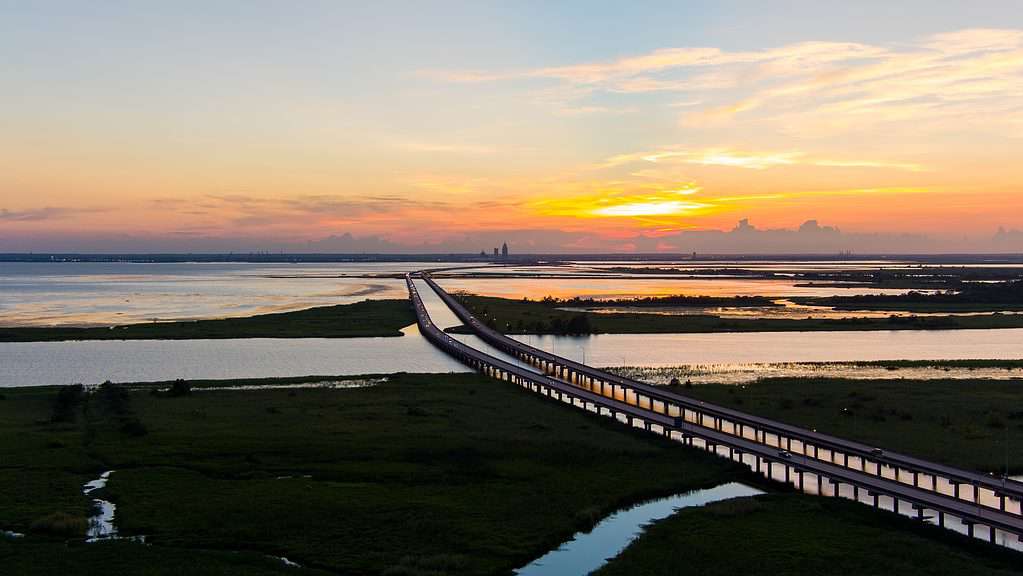
©George Dodd III/Shutterstock.com
Topping the list, the Jubilee Parkway Bridge stretches an impressive 8 miles. It claims the title of Alabama’s longest bridge and offers an unforgettable journey for commuters and travelers alike. Completed in 1978, this colossal bridge serves as a vital connector. It links the vibrant city of Mobile to the serene Eastern Shore and Spanish Fort. Furthermore, as you traverse this engineering marvel, you’ll be treated to sweeping, picturesque views of Mobile Bay, where glistening waters meet endless horizons. The Jubilee Parkway isn’t just a functional thoroughfare. It’s also a scenic experience that encapsulates the natural beauty and maritime charm of Alabama’s coastal region.
The Jubilee Parkway Bridge is more than just a feast for the eyes. In addition, it’s a lifeline for communities on both sides of the bay. It facilitates daily commutes and supports economic activities in the region. Whether you’re driving across it on a regular workday or taking in the stunning sunsets over Mobile Bay on a leisurely weekend drive, the Jubilee Parkway Bridge stands as an iconic symbol of Alabama’s maritime legacy and its commitment to modern transportation infrastructure.
2. Dolly Parton Bridge (6 miles)
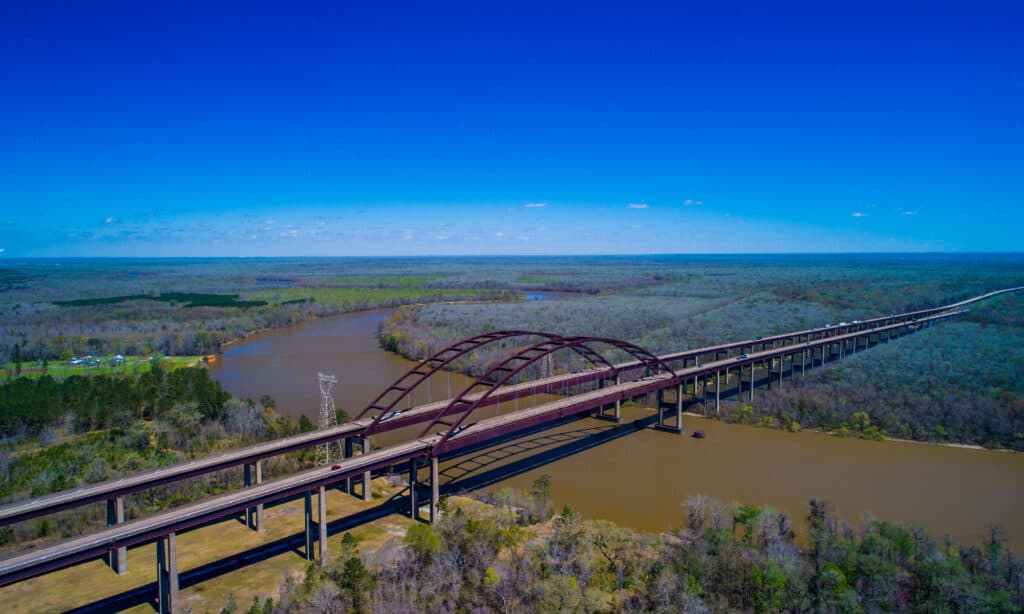
©George Dodd III/Shutterstock.com
The General W.K. Wilson Jr. Bridge, often referred to informally as the Dolly Parton Bridge, spans about 6 miles and is an essential transportation link in Alabama. Completed in 1980, this historic bridge connects the city of Mobile to its surrounding areas. Furthermore, it provides a vital passageway for commuters and travelers. Named after the legendary country singer Dolly Parton, it carries a unique charm due to its name and its iconic status in the state. As you traverse this bridge, you’ll admire the simplicity of its design and its enduring presence in Alabama’s landscape.
The Dolly Parton Bridge has withstood the test of time. Moreover, it serves as a physical link to the state’s history and musical heritage. It not only aids in daily transit but also captures the essence of Alabama’s cultural diversity. Whether you’re crossing it as part of your daily routine or exploring the region, the Dolly Parton Bridge remains a symbol of the state’s resilience, unifying the past with the present and echoing the enduring legacy of its namesake, Dolly Parton.
3. The Dauphin Island Bridge (3 miles)

©travelview/Shutterstock.com
Next, the Dauphin Island Bridge, also known as the Gordon Persons Bridge, is a vital transportation link in Alabama, connecting Dauphin Island to the mainland. Spanning approximately 3 miles, this bridge is a lifeline for residents and tourists. It provides access to the beautiful Dauphin Island, known for its stunning beaches and wildlife. The bridge, completed in 1982, is named after Gordon Persons, a former Alabama governor. Furthermore, it serves as a symbol of the state’s progress and development.
As you drive across the Dauphin Island Bridge, you’ll be treated to breathtaking views of the surrounding waters and the island’s pristine shoreline. The bridge not only facilitates travel but also enhances the experience of visiting Dauphin Island. It plays a significant role in connecting the island to the rest of Alabama and showcases the natural beauty and coastal charm that the state has to offer. The Dauphin Island Bridge is a testament to the region’s rich history and its commitment to preserving its unique landscapes.
4. Cochrane–Africatown USA Bridge (1.4 miles)
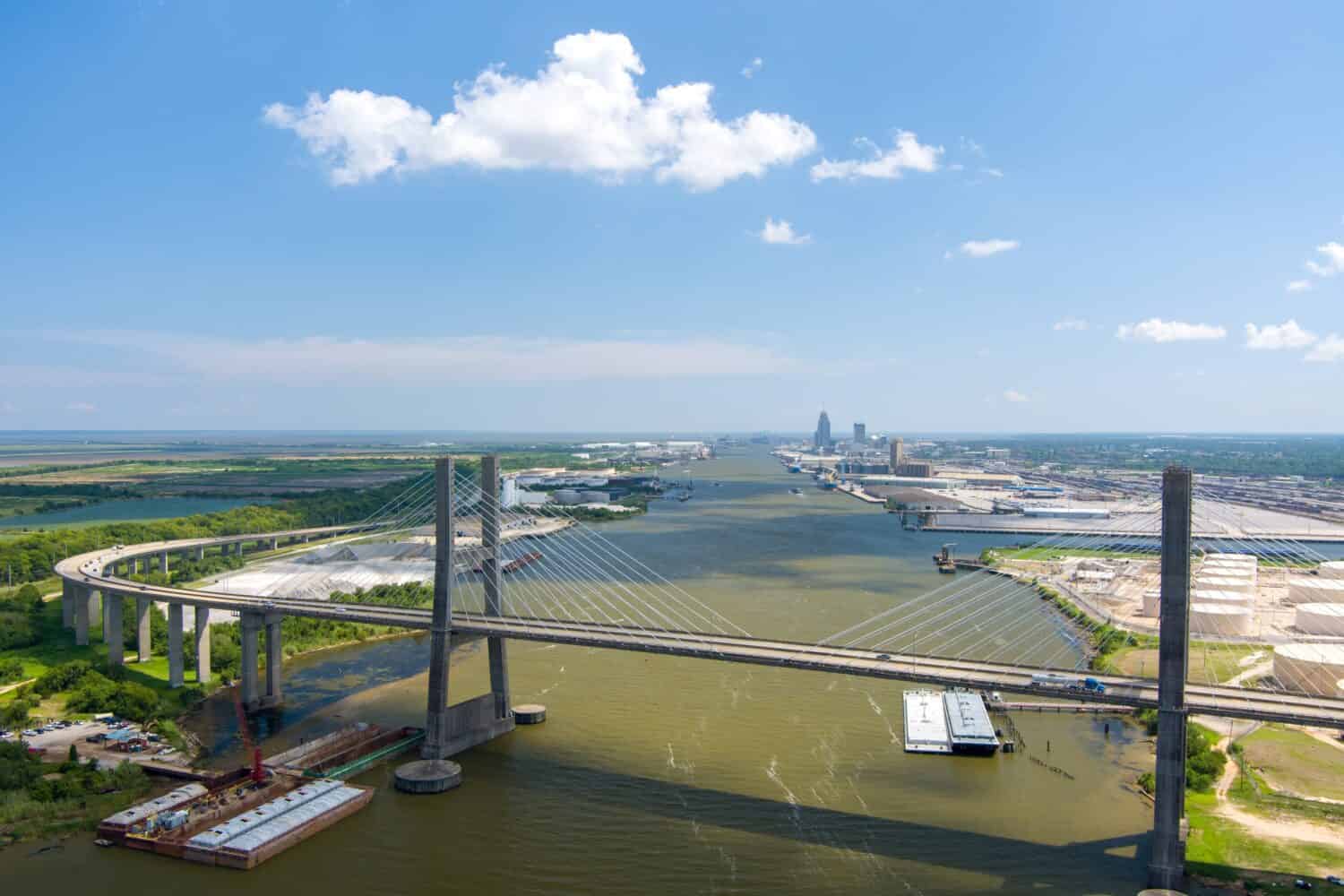
©George Dodd III/Shutterstock.com
The Cochrane–Africatown USA Bridge spans approximately 1.4 miles and stands 140 feet above the Mobile River. Notably, it serves as a vital link between communities and history in Alabama. Completed in 1991, this bridge holds special significance for the Africatown community, a historic area that is deeply tied to the state’s cultural heritage. Crossing the Mobile River, the bridge provides residents and visitors with access to the Africatown Historic District. This allows them to connect with its rich past and learn about its unique history.
As you journey across the Cochrane–Africatown USA Bridge, you will experience a connection not only in terms of geography but also with the past. This bridge signifies the endurance of the Africatown community, originally settled by the descendants of slaves who arrived on the Clotilda, the last known ship to bring enslaved Africans to the United States. Their legacy and contributions to Alabama’s history are celebrated here. Furthermore, the bridge acts as a symbolic link between their heritage and the modern world. Ultimately, it is both a practical transportation link and a testament to the resilience and heritage of the Africatown community, making it a truly unique and culturally significant structure.
5. Paul Bryant Bridge (0.7 miles)
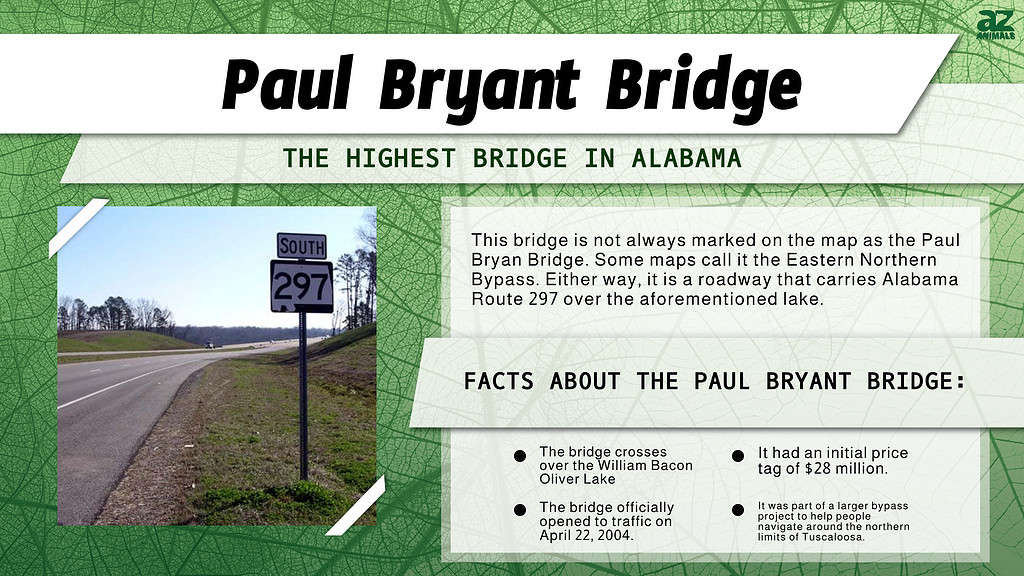
Next, the Paul Bryant Bridge, is a significant structure in Alabama that spans the Black Warrior River in Tuscaloosa. Completed in 2004, this iconic bridge stretches approximately 3,785 feet. It connects the city of Tuscaloosa to the University of Alabama campus. Furthermore, the bridge is the highest in Alabama, and it’s named in honor of the legendary football coach Paul “Bear” Bryant, who left an indelible mark on the state and the university.
As you drive across the Paul Bryant Bridge, you’ll appreciate its impressive architecture and the role it plays in facilitating travel and access to the university. It’s not just a functional bridge. It’s a symbol of the deep connection between the city of Tuscaloosa and the University of Alabama. The Paul Bryant Bridge stands as a tribute to the rich football tradition and cultural heritage of Alabama. Ultimately, it remains a point of pride for locals and visitors alike.
6. Bankhead Tunnel (0.6 miles)
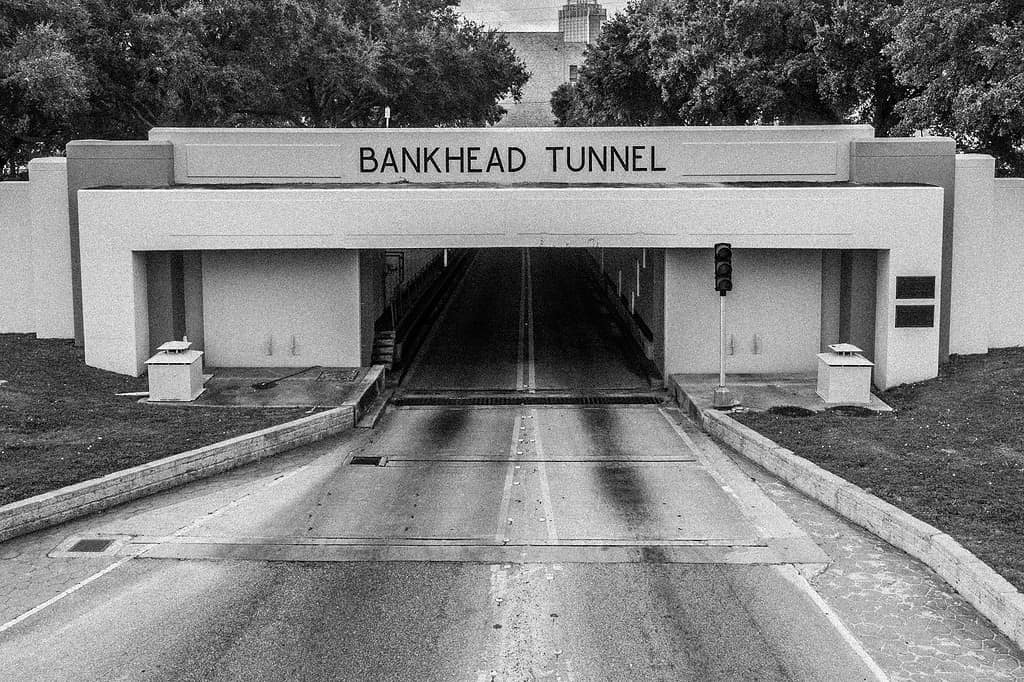
©iStock.com/Erik De Sousa
Securing the sixth position is the Bankhead Tunnel, with a length of about 0.6 miles. The Bankhead Tunnel, a historic structure that stretches beneath the Mobile River, is a notable transportation link in Alabama. Completed in 1942, the tunnel has played a significant role in connecting the city of Mobile to its eastern counterparts. As you make your way through this tunnel, you are transported back in time to an era when its construction was considered a remarkable engineering feat. The tunnel not only facilitates the movement of people and goods but also preserves the architectural charm of its era.
The Bankhead Tunnel stands as a testament to the city’s history and progress. Named in honor of John Hollis Bankhead, a distinguished figure in Alabama’s political legacy, the tunnel reflects his contributions to the state. Whether you’re a local resident or a curious tourist, the Bankhead Tunnel offers a blend of nostalgia, architectural significance, and the intriguing experience of passing beneath the river’s depths.
7. George Wallace Tunnel (0.6 miles)
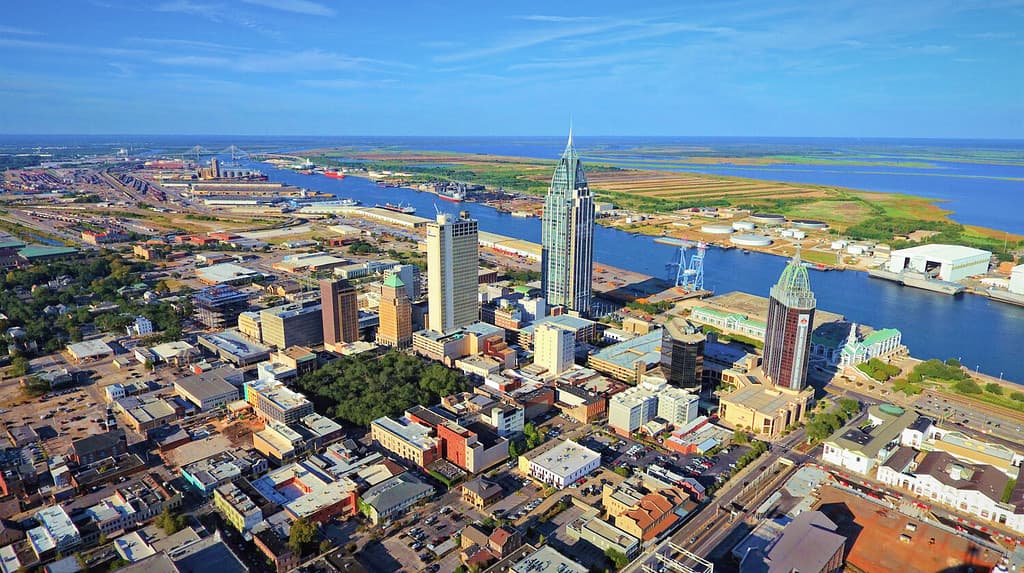
©George Dodd III/Shutterstock.com
Taking the seventh spot is the George Wallace Tunnel, with a length of approximately 0.6 miles. The George Wallace Tunnel is an integral part of Alabama’s transportation network. It stretches beneath the Mobile River, connecting the city of Mobile to the eastern part of the state. Completed in 1973, the tunnel serves as a crucial passage for both interstate and local traffic. Furthermore, it facilitates the flow of goods and people between the city and surrounding areas. Travelers embarking on a journey through this tunnel are met with a sense of adventure as they traverse beneath the river. Overall, this is a unique experience that captures the essence of Alabama’s infrastructure.
The George Wallace Tunnel has become an iconic structure in the region, symbolizing progress and connectivity. Its construction marked a significant development in the area’s transportation system, enhancing accessibility and supporting economic activities. Whether you’re a daily commuter or a tourist exploring the state’s southern regions, this tunnel offers both practicality and fascination. As you pass through its dimly lit, cavernous expanse, you can feel the pulse of the city above and the river’s flow beneath.
8. Edmund Pettus Bridge (0.24 miles)
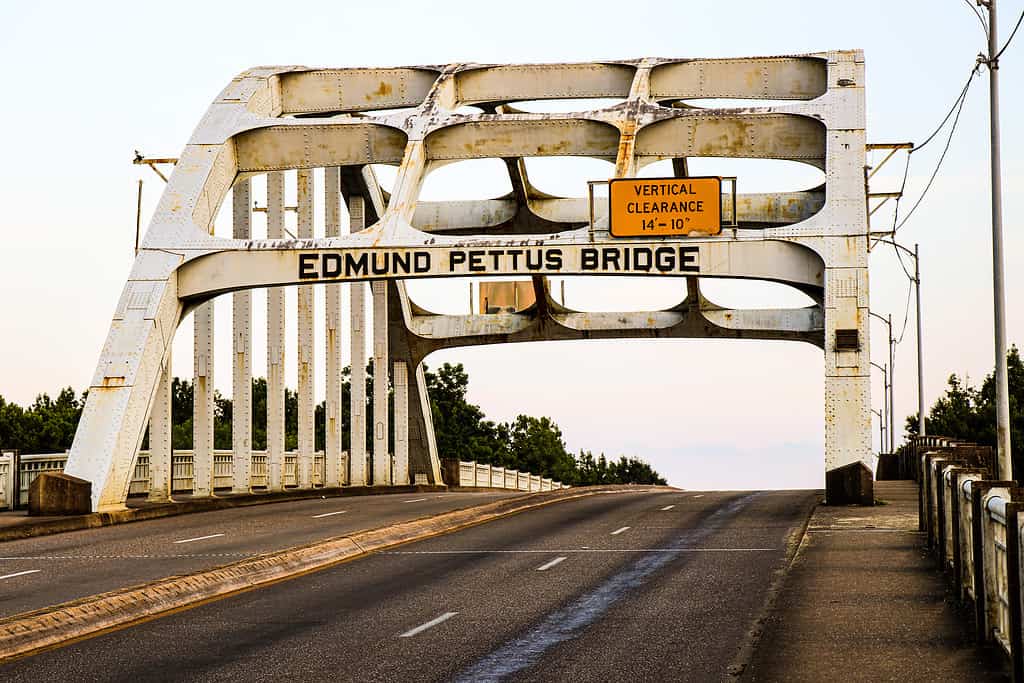
©Dennis Rosario/iStock via Getty Images
The Edmund Pettus Bridge, extending approximately 1,248 feet across the Alabama River, is a pivotal historical landmark in Selma, Alabama. Completed in 1940, this bridge carries a profound significance in the civil rights movement and American history. It was on this bridge that the “Bloody Sunday” events of March 7, 1965, unfolded. On that faithful day, peaceful civil rights marchers were met with brutal police violence. The bridge became an iconic symbol of the struggle for racial equality and justice in the United States.
The Edmund Pettus Bridge serves as a living testament to the tireless efforts of civil rights activists and their determination to secure equal voting rights for all citizens. Its historical importance has made it a symbol of courage and resilience. In addition, it has since been designated a National Historic Landmark. Travelers and historians who cross this bridge today are reminded of the sacrifices made in the fight for civil rights. Ultimately, it is a place of reflection and remembrance for visitors from all over the world.
Conclusion
Finally, as we conclude our exploration of Alabama’s longest bridges, we’ve embarked on a journey that has taken us through the remarkable landscapes and rich history of this beautiful state. From the sprawling Jubilee Parkway that offers breathtaking views of Mobile Bay to the historic significance of the Edmund Pettus Bridge, we’ve discovered that these structures are not merely transportation links but repositories of stories and culture. As they gracefully span rivers, bays, and reservoirs, these bridges embody the spirit of Alabama, connecting communities and preserving the state’s unique heritage. As we continue to cross these remarkable structures, let us remember their significance and the role they play in shaping Alabama’s future while honoring its past.
| Rank | Bridge | Length |
| #1 | Jubilee Parkway | 8 miles |
| #2 | Dolly Parton Bridge | 6 miles |
| #3 | The Dauphin Island Bridge | 3 miles |
| #4 | Cochrane–Africatown USA Bridge | 1.4 miles |
| #5 | Paul Bryant Bridge | 0.7 miles |
| #6 | Bankhead Tunnel | 0.6 miles |
| #7 | George Wallace Tunnel | 0.6 miles |
| #8 | Edmund Pettus Bridge | 0.24 miles |
The photo featured at the top of this post is © George Dodd III/Shutterstock.com









